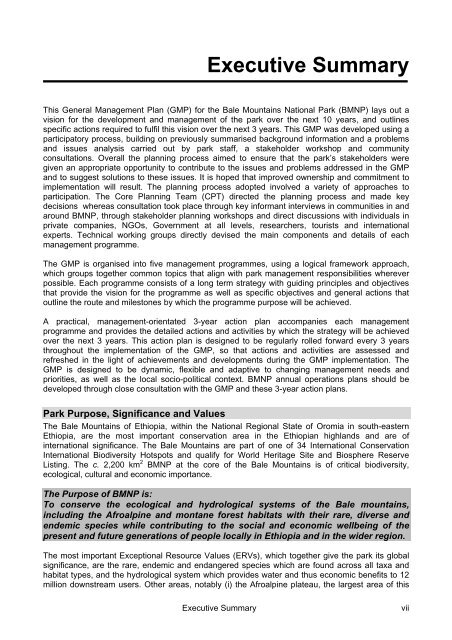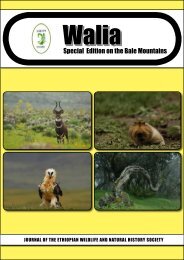Bale Mountains National Park - Zoologische Gesellschaft Frankfurt
Bale Mountains National Park - Zoologische Gesellschaft Frankfurt
Bale Mountains National Park - Zoologische Gesellschaft Frankfurt
Create successful ePaper yourself
Turn your PDF publications into a flip-book with our unique Google optimized e-Paper software.
Executive Summary<br />
This General Management Plan (GMP) for the <strong>Bale</strong> <strong>Mountains</strong> <strong>National</strong> <strong>Park</strong> (BMNP) lays out a<br />
vision for the development and management of the park over the next 10 years, and outlines<br />
specific actions required to fulfil this vision over the next 3 years. This GMP was developed using a<br />
participatory process, building on previously summarised background information and a problems<br />
and issues analysis carried out by park staff, a stakeholder workshop and community<br />
consultations. Overall the planning process aimed to ensure that the park’s stakeholders were<br />
given an appropriate opportunity to contribute to the issues and problems addressed in the GMP<br />
and to suggest solutions to these issues. It is hoped that improved ownership and commitment to<br />
implementation will result. The planning process adopted involved a variety of approaches to<br />
participation. The Core Planning Team (CPT) directed the planning process and made key<br />
decisions whereas consultation took place through key informant interviews in communities in and<br />
around BMNP, through stakeholder planning workshops and direct discussions with individuals in<br />
private companies, NGOs, Government at all levels, researchers, tourists and international<br />
experts. Technical working groups directly devised the main components and details of each<br />
management programme.<br />
The GMP is organised into five management programmes, using a logical framework approach,<br />
which groups together common topics that align with park management responsibilities wherever<br />
possible. Each programme consists of a long term strategy with guiding principles and objectives<br />
that provide the vision for the programme as well as specific objectives and general actions that<br />
outline the route and milestones by which the programme purpose will be achieved.<br />
A practical, management-orientated 3-year action plan accompanies each management<br />
programme and provides the detailed actions and activities by which the strategy will be achieved<br />
over the next 3 years. This action plan is designed to be regularly rolled forward every 3 years<br />
throughout the implementation of the GMP, so that actions and activities are assessed and<br />
refreshed in the light of achievements and developments during the GMP implementation. The<br />
GMP is designed to be dynamic, flexible and adaptive to changing management needs and<br />
priorities, as well as the local socio-political context. BMNP annual operations plans should be<br />
developed through close consultation with the GMP and these 3-year action plans.<br />
<strong>Park</strong> Purpose, Significance and Values<br />
The <strong>Bale</strong> <strong>Mountains</strong> of Ethiopia, within the <strong>National</strong> Regional State of Oromia in south-eastern<br />
Ethiopia, are the most important conservation area in the Ethiopian highlands and are of<br />
international significance. The <strong>Bale</strong> <strong>Mountains</strong> are part of one of 34 International Conservation<br />
International Biodiversity Hotspots and qualify for World Heritage Site and Biosphere Reserve<br />
Listing. The c. 2,200 km 2 BMNP at the core of the <strong>Bale</strong> <strong>Mountains</strong> is of critical biodiversity,<br />
ecological, cultural and economic importance.<br />
The Purpose of BMNP is:<br />
To conserve the ecological and hydrological systems of the <strong>Bale</strong> mountains,<br />
including the Afroalpine and montane forest habitats with their rare, diverse and<br />
endemic species while contributing to the social and economic wellbeing of the<br />
present and future generations of people locally in Ethiopia and in the wider region.<br />
The most important Exceptional Resource Values (ERVs), which together give the park its global<br />
significance, are the rare, endemic and endangered species which are found across all taxa and<br />
habitat types, and the hydrological system which provides water and thus economic benefits to 12<br />
million downstream users. Other areas, notably (i) the Afroalpine plateau, the largest area of this<br />
Executive Summary vii
















